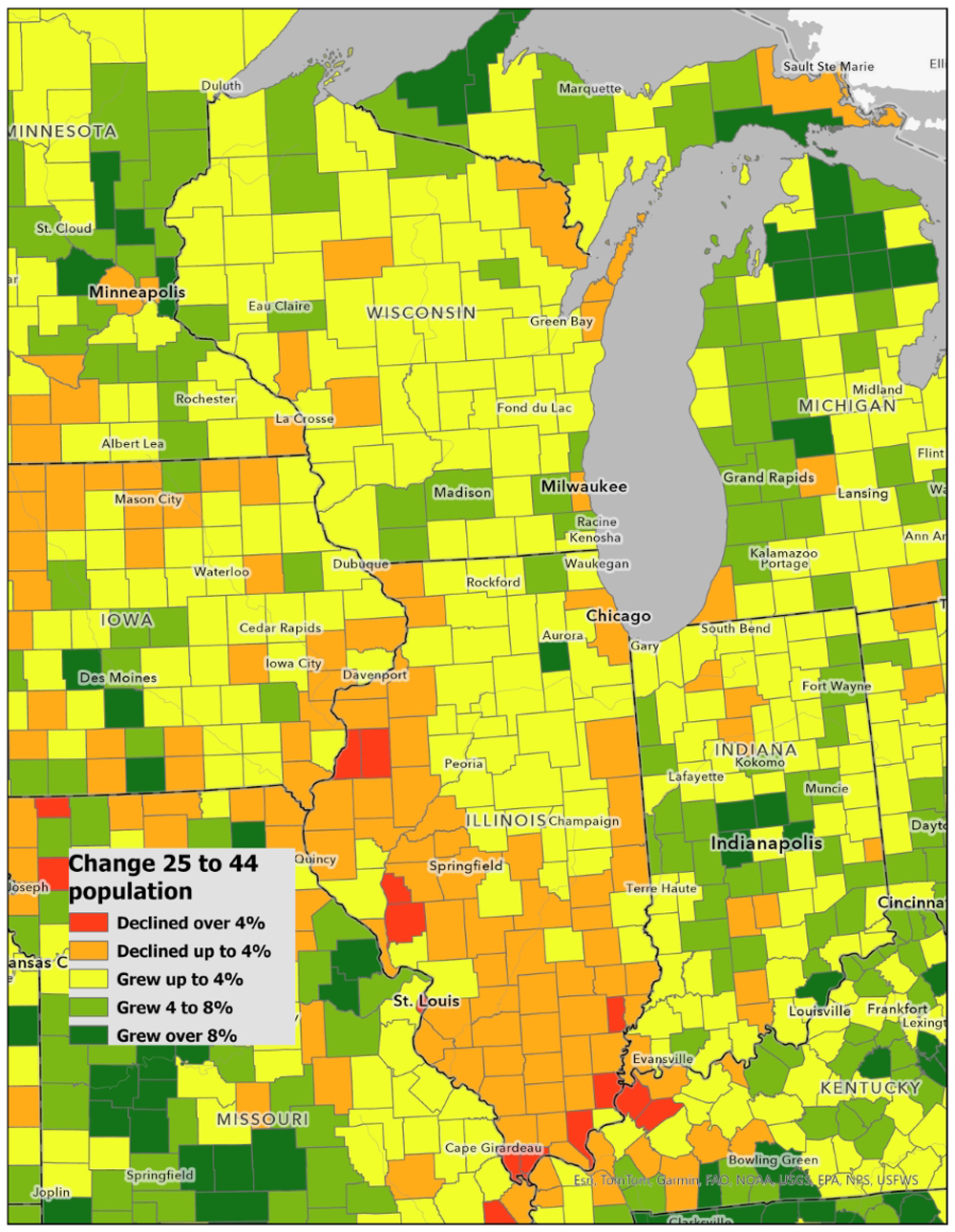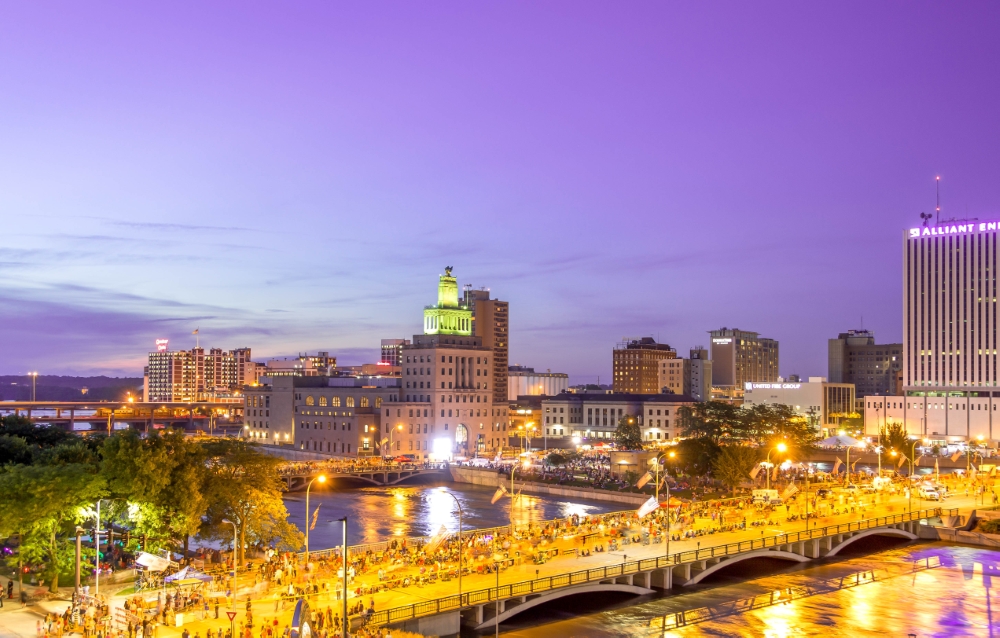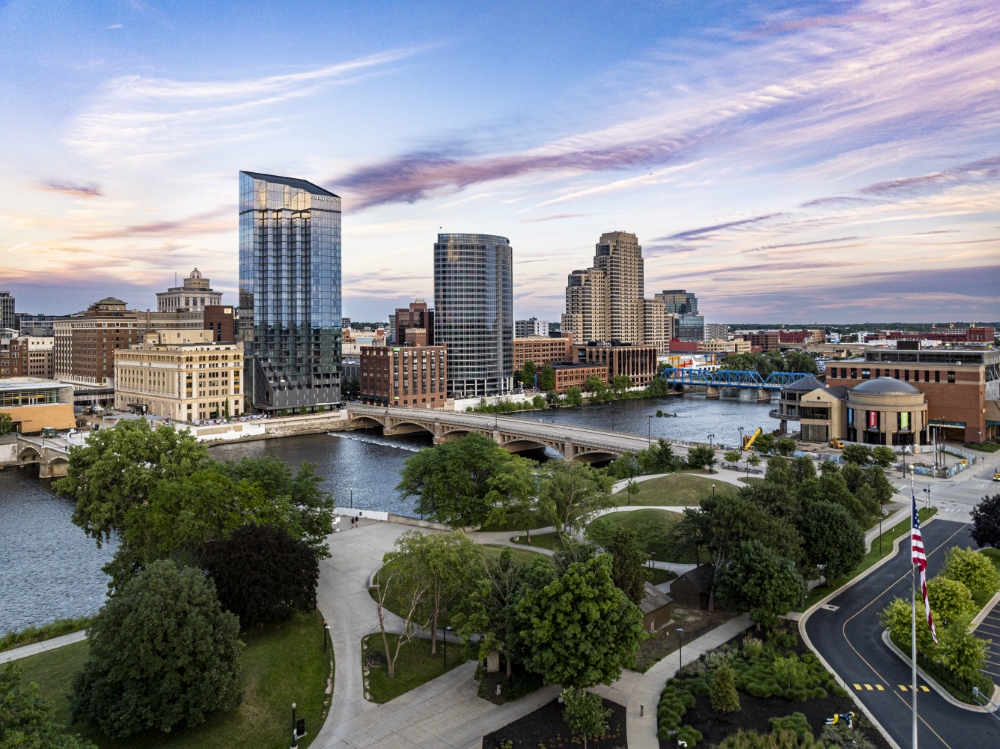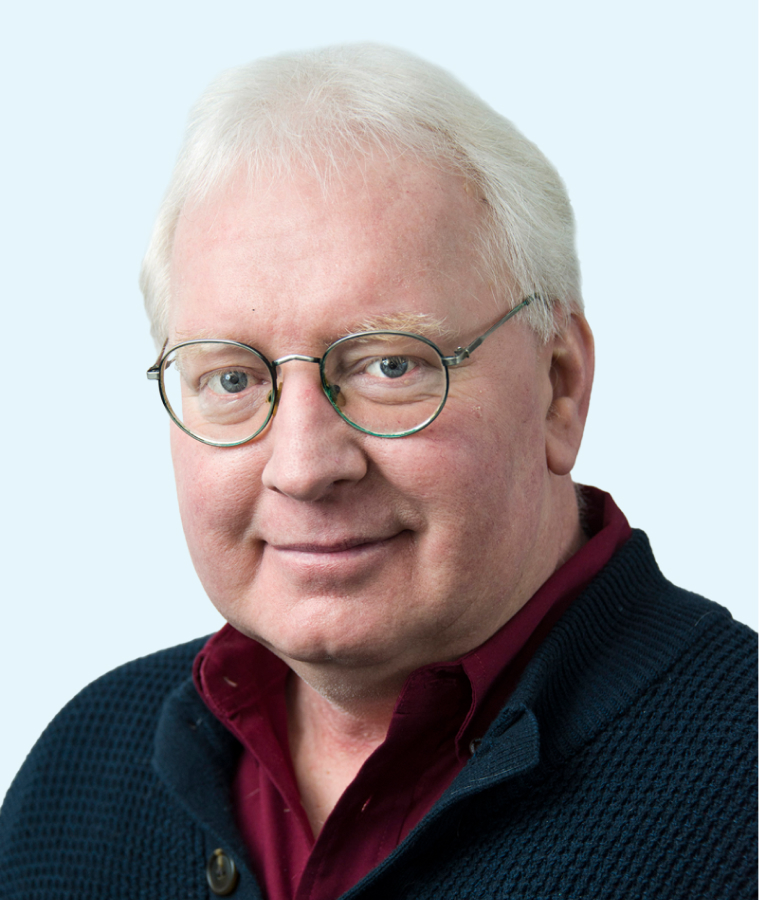By attracting talented young workers, this 6-state region is shaking off the rust.
If you want to know where the tech-driven industries of the future are heading, look for places gaining ground in the growth of younger, highly educated talent.
That is exactly what we did, and the results may surprise you. According to demographic data compiled by the Weldon Cooper Center for Public Service at the University of Virginia, we now know where the younger half of the U.S. workforce is moving to in the Upper Midwest and why. The biggest takeaways from this study are as follows:
- Michigan and Indiana are the two states that are adding the most people in the 25-to-44-year-old demographic group within the region that includes Iowa, Illinois, Indiana, Michigan, Minnesota and Wisconsin.
- Des Moines, Fort Wayne, Grand Rapids, Indianapolis and Madison are the top five Upper Midwest metros adding the most people in this age range.
- Manufacturing jobs, affordable housing and the rapidly rising cost of living in overheated Southern states are the biggest factors driving the growth of younger workers in the Upper Midwest’s most vibrant metro areas.
Demographic researcher Hamilton Lombard of the Cooper Center conducted this data analysis exclusively for Site Selection by comparing population changes among 25-to-44-year-olds from the 2010s to the 2020s. What he discovered bodes well for the future economic prospects of a once-beleaguered region of the country.
“A decade ago, all six states were losing more residents to other states than they were attracting,” Lombard reports. “Last year, four of the six states were still losing more residents than they were attracting, but the losses had shrunk for every state. In 2024, the six states lost close to 55,000 more residents to other parts of the country than they attracted.” A decade ago, the region was shedding 150,000 people a year.
Several factors explain the turnaround, says Lombard. First is the stabilization and recovery of some of the key manufacturing industries in the Upper Midwest. “Michigan, Indiana, Iowa and Wisconsin make up four of the five states with the largest shares of their workforce employed in manufacturing jobs; and Minnesota and Illinois also have relatively large manufacturing industries,” he notes.
Why Young Workers Like the Midwest
Secondly, the biggest demographic shift has come in the change in population of 25-to-44-year-olds in the region. “This data shows the reversal in trends even more clearly,” he says. “The six states’ populations age 25 to 44 fell by 93,000 in the first four years of the 2010s but have risen by 237,000 since 2020. The younger half of the workforce is growing in all six states, with the fastest growth rates in Michigan and Indiana.”
International immigration is a big factor in the Upper Midwest turnaround, says Lombard, as young, talented workers gravitate to metros offering good-paying jobs. Des Moines has seen the fastest growth rate in younger workers since 2020, followed by Fort Wayne, Grand Rapids, Indianapolis and Madison.
“In most of the Midwest, the workforce isn’t growing faster than the rest of the country today, but it is growing, which is a significant shift from a decade ago,” Lombard says. “Michigan’s acceleration in the younger half of its workforce is one of the largest in the country, nearly tying Georgia since 2020. Wisconsin, Indiana and Illinois are among the 20 states with the largest increases in their younger adult population since 2020.”
The job market and housing affordability contribute. “The improvement in the region’s economy has certainly helped, but the combination in the growth in remote work and the runup in housing prices after the pandemic has encouraged more younger adults to stay or relocate to the region,” adds Lombard. “Today, the Midwest has some of the most affordable housing relative to income in the country.”
What used to drive people south is now shifting them north. In 2010, the median home price in Chicago was a third higher than Atlanta’s. Today, home prices in Atlanta are 20% more than in Chicago while Atlanta’s income levels are lower.
These prevailing shifts — the manufacturing renaissance and rising housing affordability — are propelling knowledge talent to either remain in the Upper Midwest or relocate to it. A recent Brookings Metro study of the most AI-ready metros in the country revealed pockets of knowledge capital in the region.
“Geography matters,” says Mark Muro, senior fellow at Brookings Metro. His study measures every U.S. metro on 14 metrics such as talent levels, innovation infrastructure and business adoption to determine the AI readiness of regional economies. Familiar places stand out as the two “Superstar” metros: San Francisco and Silicon Valley.
Change In 25-to-44-Year Old Population

Source: Weldon Cooper Center for Public Service, University of Virginia
After that, however, the Upper Midwest boasts two metros deemed by Brookings to be “Star Hubs.” They are Chicago-Naperville-Elgin and Minneapolis-St. Paul-Bloomington. The third tier, called “Emerging Centers,” includes Madison and Detroit.
Where AI Readiness Is Increasing
“Key metros in the Sunbelt and the Upper Midwest now matter in the artificial intelligence sector,” notes Muro. One reason these cities stand out is because they are among the earliest adapters to the digital infrastructure needed to power the AI hyperscale computing of the future. Places like Chicago, Madison and Cedar Rapids, Iowa, are leading the way.
Chicago ranks as the ninth-largest data center hub in the world, while Madison and Cedar Rapids climb the charts. QTS Data Centers recently announced major capital investments in these Wisconsin and Iowa markets.
On July 14, the Sterling, Virginia-based QTS announced plans to construct a 15-building data center campus in the Wisconsin state capital. Each facility will require an investment of $300 million to $500 million. Yahoo Finance estimates the value of Blackstone-owned QTS at around $60 billion.
A QTS executive said the firm started looking at Wisconsin while working with Alliant Energy on a separate project in Iowa. That turned out to be a $10 billion project announcement in Cedar Rapids on August 8. The 22-year-old company plans to build a giant data center campus on a 612-acre site in the Big Cedar Industrial Center.
Investments like these are emblematic of improving economic fortunes in the Upper Midwest. In CNBC’s Top States for Business for 2025, Michigan reached its highest mark ever at No. 6, while Indiana placed No. 9 and Minnesota No. 10. Illinois checked in at No. 13, while Wisconsin placed No. 21. Iowa is No. 24.
Cedar Rapids, Fort Wayne to Professionals:
COME ONE COME ALL

Cedar Rapids on the Fourth of July and Market After Dark are two big events in this community of 135,000 people in eastern Iowa.
Image courtesy of Cedar Rapids Metro Economic Alliance
Of the five communities that recently joined the MakeMyMove initiative to attract new residents, four are in the Upper Midwest: Cedar Rapids, Fort Wayne, Southwest Michigan and Switzerland County, Indiana.
MakeMyMove is an online relocation marketplace that partners with cities to incentivize people to move there. We interviewed leaders in Cedar Rapids and Fort Wayne to learn more about their talent attraction efforts.
Jodi Schafer, director of talent attraction for the Cedar Rapids Metro Economic Alliance, says that the early returns are positive. “We just launched the program in July, and already we have seen some candidates come into our pipeline,” she says. “Everybody we talked to was very enthusiastic. They are software engineers, auditors, accountants and other high-level professionals who are applying to the program.”
Cedar Rapids, which has 134,758 residents, offers a $5,000 relocation incentive for qualifying movers. They also receive a parks and recreation voucher and a Cedar Rapids MEA membership for one year. The local minor league baseball team, the Kernels, is pitching in a 5-game package deal to the ballpark. On top of that, a Community Champions welcome program helps new residents integrate into the area.
“This is part of a larger talent attraction initiative,” says Schafer. “The mayor brought in a placemaking firm from New York City. We think this is worth the investment. It is part of our branding campaign for the Cedar Rapids region. Phase two will be an even bigger digital campaign. Our goal is to achieve 15 new movers by the end of the year.”
Schafer says a surprising finding is that a lot of the inquiries come from people in California, Florida and the Northeast. She says they are attracted to Cedar Rapids because “we are a very family-friendly place with lots of activities for kids. The type of people who will thrive here could be a young professional or a working family. Plus, there is not much of a commute, and people find it easy to get to know others in the community. Sometimes, it feels like we are a throwback to the 1960s.”
Ron Turpin, an Allen County commissioner in Fort Wayne, says the goal is simple: “Grow our population.” Fort Wayne has 273,736 residents, while Allen County as a whole has just over 400,000.
“We want to attract more people with degrees,” says Turpin. “The program is just now starting to show fruit. The real work will take place over the next year.”
Turpin says the three main goals for the region over the last 10 years have been to grow the population, increase wages and improve attainments rates for degrees and credentials.
“We are already one of the fastest-growing regions in the Midwest, but we want to keep that going and attract more professionals,” he notes.
Each community in the county decides what level of stipend to offer. The City of Fort Wayne offers a 5% downpayment plus closing cost assistance on a new home, a one-year coworking membership and one week of groceries, among other benefits.
“We want to get them acclimated to our leadership structure, and we want them to experience our high quality of life, which includes over 150 miles of trails, lots of lakes and watersports, affordable homes, short commutes and world-class schools,” Turpin says. “Our bottom-line message to newcomers is: This is a dynamic and thriving community. Come check it out for yourself.”

